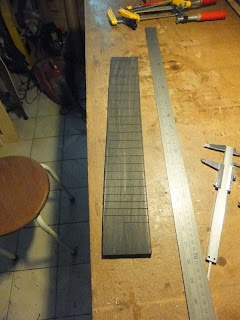Welcome to my guitar building blog.
This blog describes my journey into the world of guitar building.
I like to share my experience of building and hopefully it can be of some help to all the guitar making enthusiast.
Hope you enjoy my blog post!
2014-08-28
Preparing the fingerboard
20140821
I also prepared the fingerboard.
I marked the center line and measured the correct width and saw almost to size
After that I plane the fingerboard until the line.
Following that I marked the circle from the soundhole and cut the ends to shape.
I included a 20th fret for this guitar.
The bass side was also thin to be 1mm lower than the treble side
20140825
I patch the section of the rosette channel.
I just clean up the channel and cut a spruce patch to match the channel.
After that apply glue and clamp.
When the glue dry, I will level it.
Actually it is not really necessary to patch, I know a lot of maker doesn't bother.
But I believe having a solid area underneath the the fingerboard is crucial the upper fret treble response.
So since I have already a massive neck underneath, it doesn't make sense to have it undermined by a hole weakness in the area.
20140828
I finish up the curved part of the fingerboard at the sound hole.
Mainly I trace it with white color pencil using the sound hole itself.
The fingerboard is shaped using chisel to remove the bulk of the material followed by file and finally sander drum to finish up.
Now it's ready for gluing.
Also, I planed down the rosette patch at the soundhole.
Subscribe to:
Post Comments (Atom)














No comments:
Post a Comment